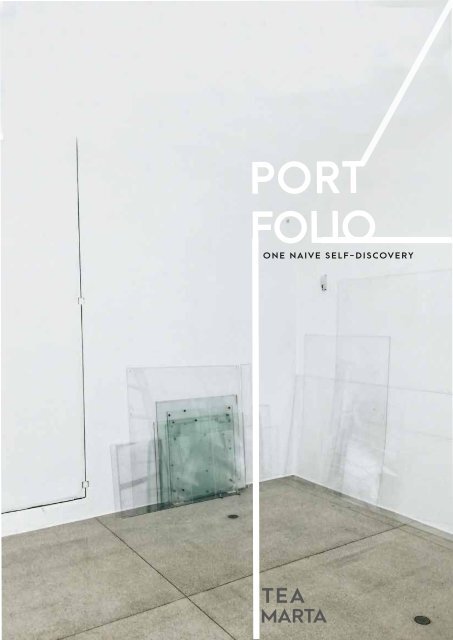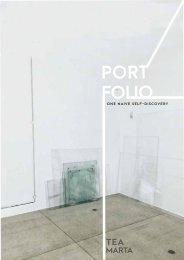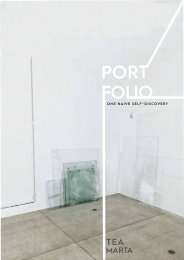Create successful ePaper yourself
Turn your PDF publications into a flip-book with our unique Google optimized e-Paper software.
port<br />
folio<br />
one naive self-discovery<br />
tea<br />
MARTA
PORTFOLIO<br />
2015-2017<br />
bACHELOR<br />
01<br />
INTUITIVE TRAJECTORIES<br />
1ST SEMESTER<br />
WS15-2016<br />
PROF. CHRISTINA CONDAK<br />
DANIELA HEROLD<br />
02<br />
adp platform (analogue,digital,production)<br />
deep spaces<br />
2ND SEMESTER PROF. WOLFGANG TSCHAPELLER<br />
SS-2016<br />
WERNER SKVARA<br />
03<br />
cmt platform (construction,materials,technology)<br />
fabric of place<br />
3RD SEMESTER<br />
WS16-2017<br />
PROF. MICHELLE HOWARD<br />
LUCIANO PARODI<br />
04<br />
other works
intuitive<br />
trajectories<br />
christina condak // daniela herold
studio 1 // WINTER2015/16
design without a project<br />
“To experiment is at first more valuable than to produce; free play in the beginning develops courage.<br />
Therefore, we do not begin with theoretical introductions; we start directly with material.” -Josef<br />
Albers<br />
We started working with everyday objects by analysing them through drawings, photographs,<br />
collages and model making. My object was the plastic cover that holds the bottle of whiskey. Basically,<br />
it is a container that is contained and contains a container. Taken out of its box, my container<br />
would not really make sense on its own. But once you start experimenting with it, one can find a lot of<br />
hidden properties.What happens when you blow it up in scale? Or when you reconstruct it out of<br />
different materials?<br />
I divided my object and worked mostly with the different pieces that I got. All these pieces looked like<br />
little capsules, which immediately made me think of brutalist architecture with all its repetitive<br />
modules.<br />
Spaces started to appear throughout my pieces. Spaces that could be connected and myriad of<br />
ways, just like in Lego games. I could start imagine life in these little capsules;being really easy to<br />
change the way they connect, adding or removing modules depending on circumstances.<br />
I reproduced my container and also parts of it in paper and plaster in different scales, each time<br />
discovering something new.
ack_view<br />
front_view<br />
top_view<br />
left_view
paper model_interior
section through successive modules
deep spaces<br />
wolfgANG TSCHAPELLER // WERNER SKVARA
studio 2 // adp PLATFORM sUMMER2016
Fragmented Flexibility<br />
Does the space influence our way of thinking? Does it affect the birth of an idea? Spaces can make you feel small,<br />
uncomfortable and trapped, but they can also free your imagination, show you that everything is possible. In a society<br />
where only the individual success is being promoted, we need a new type of teaching suitable for the times we are living<br />
in, a space that can speak for itself. Especially the upcoming architects, they need to learn how to work with each-other,<br />
exchange ideas and create. No walls that coldly divide, no more boxes or straight lines. Only transparency and playful<br />
lines.<br />
The translation of the found settlement in a hanging model was an intriguing task, for the hanging model is a reactive<br />
model that perpetually changes it appearance under different factors. The first sketch model was aimed to show the<br />
connections between fake chains, for the elements used were paper-clips that can easily be connected and again<br />
disconnected to each other. The sketch model was completely unstable and permanently changeable.<br />
At this point I realised that the little stiff elements, when connected, create a beautiful, fragmented flexibility.<br />
I began by creating my own segments which I wanted to use out of pieces of wood and earrings needles. These<br />
segments allow lots of experimentation in terms of connections, resulting different types of more or less stable elements.<br />
The segments started to lose their purpose of only figurative objects and began more and more to be part of a structural<br />
construction – they were not meant anymore just to define the space, but to enclose it. Among these elements, the<br />
stability of the project demanded weights, which led to deformation and the creation of new forms.<br />
The created workspaces aim to encourage the students that everything is possible, that the imagination has no limits.<br />
There're no straight walls or floors (”an uneven floor is a melody to the feet”).<br />
There're no conventional ways of teaching, no desks. Every line flows naturally.
collective_site_plan
SPACES ARRANGEMENT<br />
OUTLINES REACTING AS CATENARY<br />
CURVES<br />
POSSIBLE CONNECTIONS<br />
BETWEEN SEGMENTS
front view<br />
top view
HANGING MODEL<br />
SCALE_1:25
CLOSE-UP_DIFFERENT_CONNECTIONS
DIGITAL MODEL_CLOSE-UP<br />
INTERIOR VIEW_AMPHITHEATRE
SECTION
STANDING MODEL_SCALE_1:25<br />
CLOSE-UP_CONNECTIONS_BETWEEN_SEGMENTS
FABRIC OF PLACE<br />
MICHELLE HOWARD // LUCIANO PARODI
STUDIO 3 // CMT PLATFORM WINTER2016/17
The City of Sankt Valentin in lower Austria has asked the CMT (Construction, Materials &<br />
Technology) platform of the Academy of Fine Arts Vienna to design and build prototypes for<br />
6 bus-stops at strategic positions. Situated in disparate areas lacking in reciprocity, the 6<br />
bus-stops are clearly related to each other, weaving a common thread while assuming their<br />
identity as singular objects.<br />
They respond to very particular social, environmental and technological requirements, both<br />
on the micro scale of each place and that of the city and its inhabitants. This is also a<br />
research project and studies the exciting new technology of woven textile reinforcement,<br />
which replaces steel and its associated corrosion problem. Offering myriad possibilities of<br />
form through folding and shaping, extremely strong,thin skins and the free movement and<br />
integration of data, it would allow us to build with far less materials in the future. With it, we<br />
will construct the fabric of place in Sankt Valentin and one of the first free-standing textile<br />
concrete structures in Europe.<br />
The students of the CMT Platform have constructed a successful full-scale prototype of one<br />
Bus-Stop which is currently standing at the BBB-Halle of the TU-Vienna.<br />
Press release from 7th January 2017<br />
Vienna, Austria
mathematical fold_glide reflection<br />
3rd semester ws16<br />
prof. Howard michelle and luciano parodi
folding dry concrete<br />
The main advantage of<br />
this method is the little<br />
amount of material used<br />
in order to create the<br />
formwork. The formwork<br />
was created like a<br />
scored piece of paper.<br />
The traces that are usually<br />
made before<br />
starting to fold the<br />
paper are resembled in<br />
the formwork by<br />
wooden spacers. The<br />
reinforcement mesh<br />
flows through the spacers,<br />
keeping the whole<br />
in connection.<br />
FORMWORK:<br />
Materials: wood,plywood,<br />
paper, wax, soap
3rd semester ws16<br />
prof. Howard michelle and luciano parodi
I had to apply the concrete<br />
in two shifts: first,<br />
in the flat formwork, and<br />
second, when the concrete<br />
is dry and the<br />
spacers are removed.<br />
Once the spacers are<br />
removed, the concrete<br />
can be folded and fixed<br />
in the final position,<br />
ready for the second<br />
application.
Working Together<br />
The second part of the semester was<br />
collective work. We transformed<br />
our studio into an “office” working<br />
together on delivering proposals,<br />
construction plans for the 6<br />
bus-stops and a 1:1 prototype of one<br />
of the bus-stops.<br />
My main focus (apart from helping at<br />
constructing the formwork and<br />
applying the concrete on the prototype)<br />
was to create the website for<br />
the whole project- a communication<br />
tool between us and the people<br />
of sankt valentin (and of course,<br />
people from the architectural field,<br />
or just people who are interested in<br />
the project). Thus, the website<br />
became a really important tool in<br />
our project.<br />
making of_formwork for the crumpled part
other works<br />
travel sketches, university small projects
hometown glory, romania
casa malaparte_study<br />
on the book by marida talamona
“hometown glory”, Romania
erliner dom, 2016<br />
mainzer dom, 2015<br />
constanta cazino, 2014




